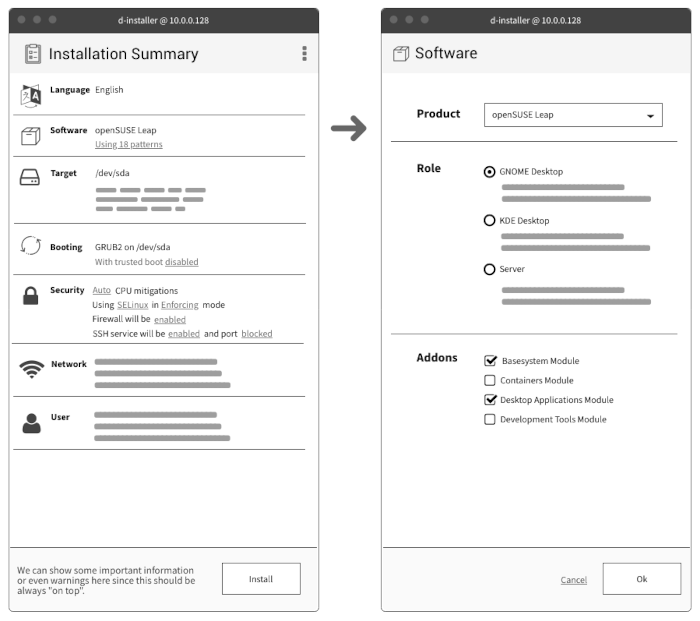We realized that, apart from the blog post presenting our D-Installer project, we have not reported any YaST activity during 2022 here in our blog. Since we are in the Beta phase of the development of SUSE Linux Enterprise 15-SP4 (which will also be the base for openSUSE Leap 15.4) we are quite focused on helping to diagnose and fix the problems found by the intensive and extensive tests done by SUSE QA department, partners and customers. We know that’s not the part of our job our audience wants to read about… and to be honest is not the part we enjoy writing about either.
Fortunately, two months after our latest regular report, we have some interesting more bits to share.
New YaST Features
While debugging and fixing issues we also found time to implement quite some interesting changes and new features in YaST. Let’s quickly go through a summary.
- Improvements in the way YaST handles the activation of encrypted devices.
- Better integration of NFS management in the Partitioner.
- Usability and speed enhancements for DASD formatting on S/390 systems.
- Support for GRUB2 password protection in AutoYaST (check the recently extended documentation for more information).
- Better handling of the errors found analyzing storage devices.
- Adapted the keyboard layouts used by YaST.
- Support for selecting during installation the desired Linux Security Module (note the screenshots on that pull request are not fully up-to-date and do not exactly reflect the current user interface).
- Improvements in how the
_netdevmount option is handled for remote file-systems. Including changes in the general handling and the new warning in the Partitioner. - Adapted YaST to be compliant with the inclusive naming initiative. This implies changes in different parts of YaST, like this, this, this or this.
- Definition of specific per-product schemas to validate the AutoYaST profiles.
- Integration of the package
yast2-firstboot-wslintoyast2-firstboot. - Adjusted creation of snapshots in YaST for transactional systems like MicroOS.
- New capability for roles and products to specify a default timeout for the boot loader configuration.
- Support for switching themes.
- Adapted handling of network configuration if iBFT (iSCSI Boot Firmware Table) is used during installation.
We also found time to implement some internal changes that, even though they don’t have a direct impact on final users, may be interesting for the more technical audience like people who usually debug or develop YaST:
- Better ways to manually test
yast2-storageand debug storage-related issues. - Usage of RSpec verifying doubles and better YaST module mocking. See this announcement in the yast-devel mailing list.
Progress on D-Installer
As you all know from our previous blog post mentioned above, we are also working on a side project codenamed D-Installer, as our main YaST duties permit. We want to turn our initial proof of concept into something that you can actually try, so the team is working on a few topics at the same time.
On the one hand, we are redefining our D-Bus API thinking about how it should look like in the future. As a side effect, Martin is improving the ruby-dbus library to support a few features that we need, like better support for D-Bus properties.
On the other hand, we are redesigning the user interface. Although we have not implemented the new design, you can see the approach we would like to follow in our mock-ups. :-)
More to Come
As you can see, we have been quite busy lately and we plan to remain so. The bright side is that both YaST and D-Installer will keep evolving at a good pace. The not-so-bright one is that we are not sure when we will be able to blog again. But we promise we will try to recover the biweekly cadence. Meanwhile do as we do and have a lot of fun!
